Related Research Articles
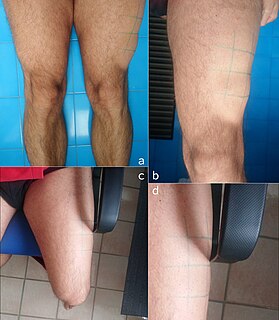
Lipoatrophia semicircularis is a medical condition in humans, commonly known as ribbed thighs.
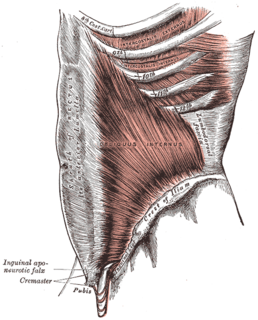
The abdominal internal oblique muscle, also internal oblique muscle or interior oblique, is an abdominal muscle in the abdominal wall that lies below the external oblique muscle and just above the transverse abdominal muscle.
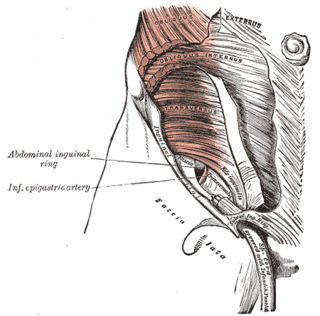
The transversalis fascia is a thin aponeurotic membrane which lies between the inner surface of the transverse abdominal muscle and the parietal peritoneum.

The arcuate line of rectus sheath, the linea semicircularis, the arcuate line, or the semicircular line of Douglas, is a horizontal line that demarcates the lower limit of the posterior layer of the rectus sheath. It is commonly known simply as the arcuate line. It is also where the inferior epigastric vessels perforate the rectus abdominis.

Somatochlora, or the striped emeralds, is a genus of dragonflies in the family Corduliidae with 42 described species found across the Northern Hemisphere.
Lipoatrophia annularis is a skin condition affecting primarily women, characterized by the loss of subcutaneous fat in the upper extremity.
Drug-induced lipodystrophy is a cutaneous condition that presents as one or multiple depressed areas, usually on the proximal extremities, ranging from under a few centimeters to greater than 20 cm in diameter.
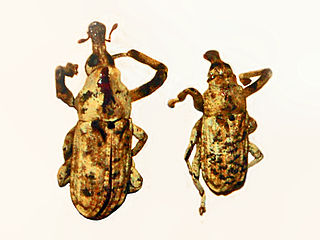
Gasterocercus is a genus of beetles belonging to the true weevil family.

Plagiostoma is a genus of fossil saltwater clams, marine bivalve mollusks in the family Limidae, the file clams.
Aethes semicircularis is a species of moth of the family Tortricidae. It is found in China.

Pterolophia is a genus of longhorn beetles of the subfamily Lamiinae, containing the following species:
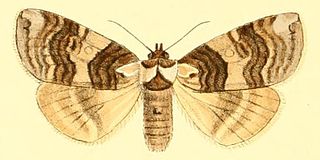
Euthyatira semicircularis is a moth in the family Drepanidae. It is found in North America, where it has been recorded from British Columbia to California, east to Utah. The habitat consists of coastal rainforests and boreal forests.
Pterolophia ingrata is a species of beetle in the family Cerambycidae. It was described by Francis Polkinghorne Pascoe in 1864.

Pterolophia melanura is a species of beetle in the family Cerambycidae. It was described by Francis Polkinghorne Pascoe in 1857. It has a wide distribution in Asia.
Pterolophia gibbosipennis is a species of beetle in the family Cerambycidae. It was described by Maurice Pic in 1926.
Pterolophia instabilis is a species of beetle in the family Cerambycidae. It was described by Per Olof Christopher Aurivillius in 1922. It is known from Seychelles.
Pterolophia guineensis is a species of beetle in the family Cerambycidae. It was described by James Thomson in 1864, originally under the genus Alyattes.
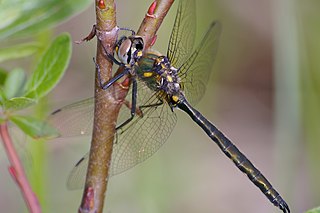
Somatochlora semicircularis, the mountain emerald, is a species of emerald dragonfly in the family Corduliidae. It is found in North America.
The torus semicircularis is a region of the vertebrate midbrain that contributes to auditory perception, studied most often in fish and amphibians. Neurons from the medulla project to the nucleus centralis and the nucleus ventrolateralis in the torus semicircularis, providing afferent auditory and hydrodynamic information. Research suggests that these nuclei interact with each other, suggesting that this area of the brain is bimodally sensitive. In the Gymnotiform fish, which are weakly electric fish, the torus semicircularis was observed to exhibit laminar organization. It receives afferent input, specifically electrosensory, mechanical, and auditory stimuli. In frogs, researchers have studied how neurons in the torus semicircularis prefer certain characteristics of sound differentially. Single neurons fire selectively based on the auditory parameters of a stimulus. Functionally, this can allow members of a species to distinguish whether a call is of the same (conspecific) or a different species. This has been observed to play a role in mate selection. In the Tungara frog, which produces a species-specific mating call, scientists studied responses in the laminar nucleus of the torus semicircularis to various parts of the call. They came to the conclusion that this part of the brain acts as a feature detector for the parts of the auditory stimulus that are conspecific. From an evolutionary standpoint, research has been conducted in turtles to connect the distribution of calcium-binding proteins in the torus semicircularis among birds and mammals to a common reptile predecessor.
References
- ↑ BioLib.cz - Pterolophia semicircularis. Retrieved on 8 September 2014.